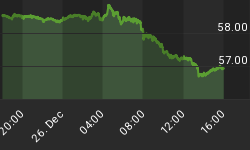Increasingly, the world is becoming more complex. I'm sure few would argue this point. Man kind's propensity to collect and analyze numbers has no doubt contributed to this situation. It is in this spirit that I have tabulated the following as 'my own contribution' (MOC) to our collective confusion.
The number of corporations in the United States that have made settlements with or paid fines to regulators (Spitzer, SEC) so far this year, 2004, in amounts exceeding 30,000,000 - 14. An additional 5 corporations have paid fines, or made settlements this year, exceeding 100,000,000 U.S. dollars. In not one of the aforementioned cases did the payee admit to one ounce of guilt or was anyone incarcerated.
The number of individuals who reportedly benefited from insider knowledge to the tune of 40,000, were accused of 'lying' and subsequently had 300,000,000 eviscerated from their net worth. Upon being found guilty, they were sentenced to 5 months in the slammer along with 5 months of house arrest and a 'token' fine - 1.
The effect of a 300 basis point (3%) increase in financing costs on the accumulated Federal debt - 39 billion/yr. This is more than 300 dollars per working person in America..
Current GDP of the U.S. economy - 11.5 trillion.
The size of U.S. commercial bank's holdings of derivatives at March 1995 - 17.5 trillion.
The size of U.S. commercial bank's derivatives holdings (sometimes referred to institutionally as a 'hedge books') as of March 04 - 76.5 trillion.
Year that Long Term Capital Management (LTCM) blew up - 1997. LTCM had capital of 4.8 billion. Derivatives book of 1.25 trillion.
Number of partners at LTCM that were Nobel laureates (economics) - 2.
Number of times LTCM reported a loss - 1. However, it was fatal and resulted in bankruptcy and very nearly collapsed the world's financial system.
The amount of derivatives held by one bank (Mar. 04), J. P. Morgan Chase - 39.6 trillion. Market cap of J.P. Morgan Chase - 13.3 billion.
Number of Nobel laureates at J.P. Morgan - ?
Number of times J.P. Morgan Chase has reported a loss on their derivatives book - 0.
Amount of notional increase J.P. Morgan Chase derivatives book increased in latest quarter (at Mar. 04) - 3.2 trillion.
Assuming there are 20 hours in a day that J.P. Morgan can viably transact business institutionally, trading minutes in a day - 1200
Assuming 22 business days per month, number of business days per quarter - 66.
J.P. Morgan total tradable minutes per quarter - 79,200.
Rate of Increase in book size this quarter: 3,200,000,000,000 / 79,200 = 40,404,040 per minute.
Who J.P. Morgan does all those trades with - ?
Number of lunch and bathroom breaks traders at J.P. Morgan take - ?
Amount of regulatory oversight over J.P. Morgan's 40 trillion derivatives book - 0
Number of 'surprises' regulators would find in said book if they looked - ?
The number of times the Bureau of Labor Statistics has withheld PPI data from the populace so far this year - 2. On 1 of these occasions their official reason was that government computers were not up to the task of tabulating the data. On the other occasion they claimed that the data they collected was unfit for consumption.
The percentage of its value the U.S. dollar has lost over the past 80 years - roughly 95%. This equates to a compounded annual rate of inflation of roughly 3.5%. The Fed has currently set a target of 2 - 3 % annual inflation.
The government's latest consumer price index reporting - an annualized rate of about 4.5%. The Fed Funds rate is currently 1.25%. Anyone investing in money market instruments is virtually guaranteed to 'lock in' a loss on their money of 2.5-3.0% per annum. Perhaps the government/Fed feels this is realistic given their expectations for the traditional alternatives, namely stocks and bonds?
The price increase of crude oil so far this year - roughly 50 %. Apparently, this should not concern anyone since Alan Greenspan has declared this increase as a 'transitory phenomena' as the price of oil approached 40.00. Did he mean 'this' increase was transitory or 'the next one?" In a related story, Alan Greenspan has also declared that inflation is not a problem.
The number of recessions in the U.S. economy since the Federal Reserve was established in 1913 - 7.
The number of depressions in the U.S. on the Federal Reserve's watch - 1.
The amount at which the Federal debt is currently rising - 52 billion per month. Accordingly, the Mogambu Guru points out that this is the equivalent of 372 dollars of additional debt per working person per month in the entire country.
The amount of Federal debt accumulated by America in the past 25 months - 1.3 trillion (Mogambu Guru).
The amount of gold the U.S. carries on its balance sheet (as reported by the I.M.F.) - 261.58 million ounces. See: http://www.imf.org/external/np/sta/ir/usa/eng/curusa.htm. Gold is listed as a component of official reserve assets (82.585 billion). *This gold is described as being deposits and, if appropriate, gold swapped. Official reserve assets are exactly equal to the line item - currencies in SDR basket - listed in memo items. Interestingly, the department of the U.S. Treasury states on their web site that, "The Special Drawing Rights (SDR) is not connected to gold and confers no right to draw physical gold from the IMF."
According to the Treasury, "Neither the ESF, nor the Treasury Department, nor the Federal Reserve made any gold swaps during this period [past 10 yrs.]."
The last time an independent audit of the U.S. gold reserve was undertaken - late 1950's.
My professor in economics 101 always said his biggest contribution (HBC) to his students was imparting the reasons why we record and analyze numbers. He said that they always told a story and they never lied - or do they?
















